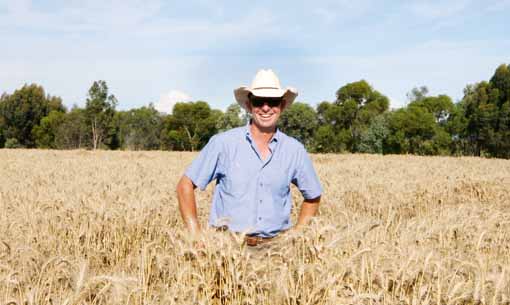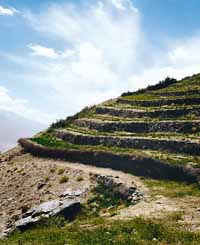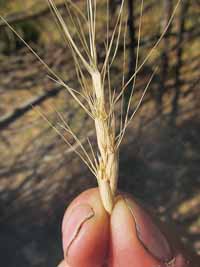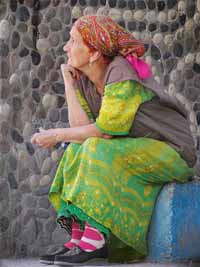Wheat genetics in Tajikistan could help feed the world

More than 4000m above sea level on one of the world’s most remote tracts of farmland, an international group of scientists and an Australian farmer are on their hands and knees, looking for wheat.
Evading landslides from the nearby mountains as well as landmines left behind from a bitter civil war more than a decade ago, the group is in Tajikistan in Central Asia on the hunt for some of the earliest varieties of the crop.
For the scientists from the Syrian-based International Centre of Agricultural Research in Dry Areas, this is part of the everyday work they do in gathering plant genes from around the world in an effort to learn more about plant tolerance and resistance.
But for Brad Stillard, who grows wheat and tomatoes in Barooga, New South Wales, being invited on the month-long trip to collect plant samples could not be further from the farm he is used to working on.
 “Farms in Tajikistan are between 0.5ha and 2ha,” he says. “Everyone is farming by hand and it’s not on a big scale. You can’t get over how steep it is either – it’s so vast and unforgiving.
“Farms in Tajikistan are between 0.5ha and 2ha,” he says. “Everyone is farming by hand and it’s not on a big scale. You can’t get over how steep it is either – it’s so vast and unforgiving.
“It’s incredibly dry, so all the land is irrigated. As soon as there’s a spring, there’s a village, but move away from a spring and it’s dry, tough and rugged.
“It’s hot in the summer and in winter it’s very harsh and has deep snow, getting to as low as -40 degrees. It’s incredible to see people farm there and to see crops thrive.”
Brad found himself on the trip after he had travelled to Syria in April 2010 to study irrigation with saline water as part of a Nuffield Farming Scholarship.
While he was there he met Ken Street, an Australian scientist known in his native country as the “Seed Hunter”.
Dr Street is renowned for a television series he filmed on his travels around the world, collecting plant genes which could be used in modern varieties to help them withstand the effects of climate change.
“We started talking about genetic diversity and the salt-tolerant crops I had seen in the different places I had been to – plants that hadn’t been modified genetically, but were still displaying salt-tolerant traits,” says Mr Stillard.
“It made me think that there is enough genetic diversity out there to find answers to agriculture’s problems and the issue of food security, if you just know what to look out for.”
It’s a view shared by Dr Street, and he invited Mr Stillard on his next seed-hunting expedition to Tajikistan, a land-locked country bordering Afghanistan, China, Uzbekistan and Kyrgyzstan and known as the “rooftop of the world” due to its huge mountains. It is also a country known as one of the world’s harshest thanks to its extreme temperatures and the conditions its population – especially its farmers – have to endure.
 “It’s very remote,” says Mr Stillard. “In half an hour of driving the heights can change by as much as 1,500m, the elevations are so extreme. But it means you get lots of microclimates, so there is lots of diversity in crop types.
“It’s very remote,” says Mr Stillard. “In half an hour of driving the heights can change by as much as 1,500m, the elevations are so extreme. But it means you get lots of microclimates, so there is lots of diversity in crop types.
“Also, because of its remoteness modern agriculture – from machines to crop varieties – has not encroached there.
“There are lots of farming villages up through the valleys. There could be one village where one crop had been growing there for decades. That crop has developed its own idiosyncrasies – genetics that are very important because the genes are specific to one area because of a combination of remoteness, harshness and the altitude.”
Mr Stillard and the scientists from ICARDA collected and recorded the locations some 360 different varieties of wheat, including some early varieties which had been growing wild on the mountainsides.
“Central Asia is the home of the grain, its growing in the wild there and it’s been farmed there for thousands of years,” Mr stillard says.
“I found wheat in one valley and it looked like two-row barley. I tried to rub the grain out and it wouldn’t, which is a sign that it’s an old variety – it didn’t look like anything we grow.
“It’s so important to find varieties like that. If you see a crop that is exposed to such a high altitude you know they are exposed to frost. If that crop is doing well, we can take the genes and use them to produce varieties that are more frost tolerant.
“Also there aren’t a lot of insecticides available up there so plants are surviving pest attacks. There is so much we can learn from these plants to help us grow better crops and produce more food.”
As well as discovering different wheat varieties, Mr Stillard says the trip has made him appreciate modern farming methods and food production systems.
“We went into one field and there were five different wheat varieties in one field. Each one has a different growth habit, so that if it goes dry then at least one will survive.
“There is only one opportunity to grow food and get it in time for winter it’s important to get at least one right.
“Seeing people grow crops that way and do everything by hand makes you realise just how much work goes into processing food,” he says.
“In one village they had a stone mill driven by a stream so they could mill their own flour and bake bread.
 “The amount of work that’s involved in getting the grain from the plant is incredible. When I’m only concerned about the climate control in my harvester, it’s a completely different world and being able to see it was incredible.”
“The amount of work that’s involved in getting the grain from the plant is incredible. When I’m only concerned about the climate control in my harvester, it’s a completely different world and being able to see it was incredible.”
He has also become more appreciative of the landscape he farms back in Australia, he adds.
“During the trip we followed valleys and rivers, and most of the time we were travelling along the Pange River looking over Afghanistan.
“We passed a lot of landslides and very often when they strike they take out roads and even entire villages.
“Luckily we were there in August, which is the safest time of year in terms of rock falls – there was probably a better chance of being hit by a land mine or shot by a member of the Taliban over the Afghan border.”
The seed samples Mr Stillard and the ICARDA team collected have now been sent back to a central laboratory in Syria to have their genes analysed. Once tested, they are approved for distribution and sent out to breeders across the globe.
“ICARDA is one of the main seed banks in the world,” says Mr Stillard. “These seed banks are where all grain breeders source material, and where they’re coming to try to find the answers to all the food production issues we’re facing.
“Hopefully by helping collect these samples, I can say I’ve contributed to the grains industry and done something towards helping the world produce more food.”
To read more about Brad’s travels, read his blog.
Takijistan
 Central Asia’s poorest country, Tajikistan became independent from the Soviet Union in 1991 and plunged into a six-year civil war which killed 50,000 people.
Central Asia’s poorest country, Tajikistan became independent from the Soviet Union in 1991 and plunged into a six-year civil war which killed 50,000 people.
Many people fled to the country’s remote, mountainous areas, putting huge pressure on rural communities and their already stretched food supplies. Many areas have never really recovered and poverty is widespread.
A number of charities have worked in the country to try to introduce more modern farming methods and plant varieties, but few of the introduced crops have survived the harsh conditions.
ICARDA
Established in the 1970s, ICARDA is an international research centre based in Syria which studies the potential threats of food shortages and loss of natural resources in dry areas. As well as being home to one of the world’s largest seed banks, ICARDA works with farmers to help them improve their production systems and deal with the challenge of drought. For more information visit their website.

